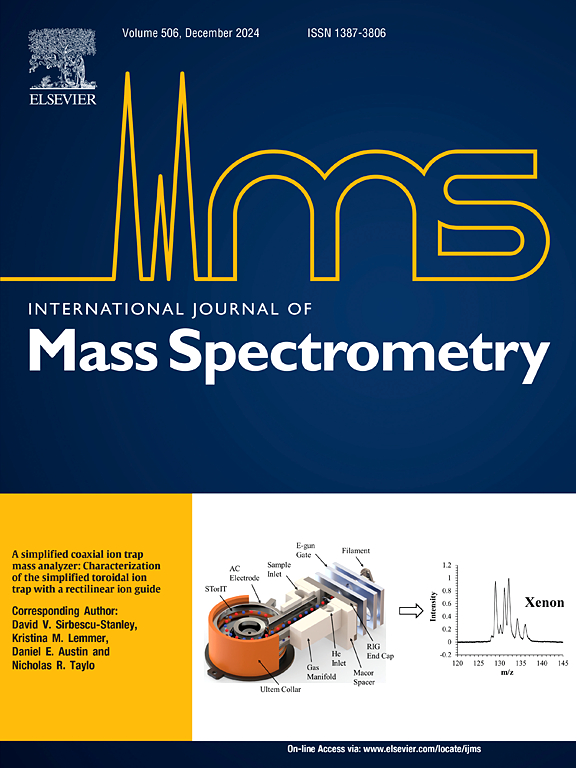Isotopic analysis of zinc plasma using Laser‒Ablation Time‒of‒Flight mass spectrometer
IF 1.7
3区 化学
Q3 PHYSICS, ATOMIC, MOLECULAR & CHEMICAL
引用次数: 0
Abstract
In this study, we present the isotope analysis of zinc plasma using laser ablation time-of-flight mass spectrometry (LA-TOF-MS). The isotopes were detected based on their mass-to-charge (m/z) ratio. To improve the resolution of LA-TOF-MS, an aluminum disk with a 1 mm central opening was placed within a cylindrical magnetic filter (∼1 T) along the ion signal path. The electric field was applied using DC power, and the signal-to-noise ratio was monitored via an oscilloscope. Zinc isotopes; Zn-64, Zn-66, and Zn-68 were observed with high resolution within 1 μs by systematically applying electric fields in the ionization and extraction regions. The full-width half maximum (FWHM) significantly decreased with increasing electric field strength, from 0.215 to 0.137 μs for Zn-64, 0.294 to 0.146 μs for Zn-66, and 0.239 to 0.190 μs for Zn-68. The mass concentrations for Zn-64, Zn-66, and Zn-68 were estimated to be 48.6 %, 27.9 %, and 18.8 %, respectively, within ±0.1 % uncertainty, which is in agreement with the reported values in the literature. Laser-induced breakdown spectroscopy (LIBS) is used for plasma characterization and rapid qualitative identification of the constituent elements in the sample under study. Energy-dispersive X-ray (EDX) spectroscopy is applied for the cross-validation of the qualitative results obtained using LIBS. Since spectroscopically pure zinc was used in this study, spectral lines of any impurity elements may also appear in both spectra. However, LA-TOF-MS yields peaks along the arrival time scale of the constituent ions in the sample. The results demonstrate that LA-TOF-MS, combined with LIBS and EDX techniques, suggest a rapid method for elemental/isotope analysis.

用激光烧蚀飞行时间质谱分析锌等离子体的同位素
在这项研究中,我们提出了使用激光烧蚀飞行时间质谱(LA-TOF-MS)对锌等离子体进行同位素分析。这些同位素是根据它们的质量电荷比(m/z)来检测的。为了提高LA-TOF-MS的分辨率,沿离子信号路径将一个中心开口为1mm的铝盘放置在圆柱形磁滤波器(~ 1t)内。使用直流电源施加电场,并通过示波器监测信噪比。锌同位素;在电离区和萃取区系统施加电场,在1 μs范围内对Zn-64、Zn-66和Zn-68进行了高分辨率的观察。随着电场强度的增加,全宽半最大值(FWHM)显著降低,Zn-64从0.215 μs降至0.137 μs, Zn-66从0.294 μs降至0.146 μs, Zn-68从0.239 μs降至0.190 μs。在±0.1%的不确定度范围内,Zn-64、Zn-66和Zn-68的质量浓度分别为48.6%、27.9%和18.8%,这与文献报道的值一致。利用激光诱导击穿光谱(LIBS)对所研究样品中的组成元素进行了等离子体表征和快速定性鉴定。利用能量色散x射线(EDX)光谱对LIBS所得定性结果进行交叉验证。由于本研究使用的是光谱纯锌,因此任何杂质元素的谱线也可能出现在两种光谱中。然而,LA-TOF-MS在样品中组成离子的到达时间尺度上产生峰。结果表明,LA-TOF-MS结合LIBS和EDX技术,是一种快速的元素/同位素分析方法。
本文章由计算机程序翻译,如有差异,请以英文原文为准。
求助全文
约1分钟内获得全文
求助全文
来源期刊
CiteScore
3.60
自引率
5.60%
发文量
145
审稿时长
71 days
期刊介绍:
The journal invites papers that advance the field of mass spectrometry by exploring fundamental aspects of ion processes using both the experimental and theoretical approaches, developing new instrumentation and experimental strategies for chemical analysis using mass spectrometry, developing new computational strategies for data interpretation and integration, reporting new applications of mass spectrometry and hyphenated techniques in biology, chemistry, geology, and physics.
Papers, in which standard mass spectrometry techniques are used for analysis will not be considered.
IJMS publishes full-length articles, short communications, reviews, and feature articles including young scientist features.

 求助内容:
求助内容: 应助结果提醒方式:
应助结果提醒方式:


